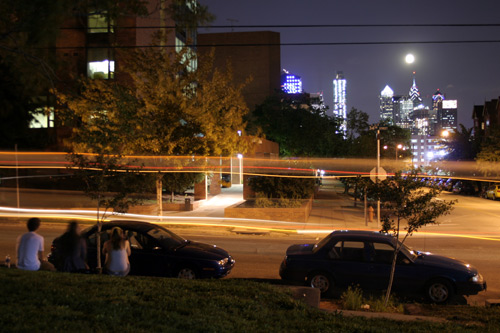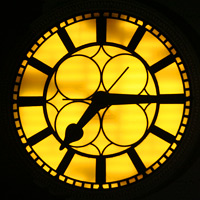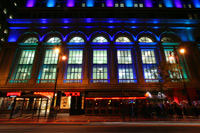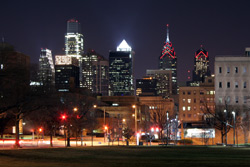20 October 08: The Possible City
Dreams of a Magic City
 by Nathaniel Popkin October 20, 2008 In this row house city sometimes we forget about what's beyond. But for standing in Center City we rarely look up -- most of the rather muscular six story factories are gone, even the occasional church steeple tumbles to the ground. This makes us grounded, and in myth at least, contributes to our long-standing distaste for ornamentation and presumption. But such an intractable and unrelieved confrontation with reality can be painful and withering. Susan Snyder, a lecturer in architecture at the Penn School of Design, once noted, with chagrin, Philadelphia's inability to overcome its own tedium. "There just isn't any fantasy in Philadelphia," she declared during a meeting to imagine a more playful Schuylkill River. In a sense, of course, her critique is as sure as a three-course wall of brick. As I've noted before on this website and in The Possible City, Philadelphia too often fails to delight, transform, and inspire. And yet let's take a careful look at that brick wall -- the aging brick and mortar -- a pair of dancing, suggestive, climbing vines, a glittering mosaic peering around the bottom corner, a weathered man in a lawn chair leaning back with his head in the sun. He wants to talk, tell his story. That's magic here, in Philadelphia. For the urban ponderer-wonderer, it's the very joy of exploration, happenstance, and surprise. Magic, it seems to me, requires mystery; that's why the encounter with the worn man and his fading wall is moving. He's someone we don't know, never would know, a gift of the city. Now, as we listen, his story becomes ours. The vast majority of Philadelphia's gifts are, like this one, treats of the day. They are meaningful, extraordinary. Now, at this time of year, glowing brick walls carry shadows of long-stretching sycamore branches; and the yellowing leaves, pitched against the sapphire sky melt and dance above. These are our jewels. There's a finely pitched urban beauty too. The city is busy. Have our streets -- and streetcars -- felt this crowded any time in the past 30 years? Winning baseball and the swelling Obama campaign compound what's really a joyful energy.  Today we can sit at a proper café table -- and, at the right time of the day feel the sun on our faces -- in the northeast corner of City Hall courtyard.
Drink take-out coffee; eat a hoagie; smile sheepishly at a lover. The two evocative Romanesque towers guarding the exit to South Broad may be enough to carry us
away. It's happening here. And as the afternoon mounts, and voices rise and children skip across Ed Bacon's compass, it begins to feel just like a little like an
urban stage.
Today we can sit at a proper café table -- and, at the right time of the day feel the sun on our faces -- in the northeast corner of City Hall courtyard.
Drink take-out coffee; eat a hoagie; smile sheepishly at a lover. The two evocative Romanesque towers guarding the exit to South Broad may be enough to carry us
away. It's happening here. And as the afternoon mounts, and voices rise and children skip across Ed Bacon's compass, it begins to feel just like a little like an
urban stage.Then, around 4:30, the umbrellas are removed from the tables and the chairs are chain-locked to the tables. The curtain begins to close. Go further into the night and the only surprise is likely to be that for such a large and complex city it's so quiet. Stores close early, transit slows down. Lights come on, sure, but cobra highway lights, as most of ours are, are designed to help you get through, and not be in the urban night. "It's disappointing," says Andrew Thompson, a City Paper intern from California and keen urban observer, who is otherwise taken with the life of this city. The disappointment is heightened in part because the city seems so engaging during the day. He can't quite figure out why it goes so quiet at night. A city at night transforms; even the most interesting urban district -- Thompson imagines Greenwich Village, we might think about parts of Istanbul, Barcelona, or Taipei -- becomes something else at night. The conversion alone is often magical; the energy of the place doesn't dissipate, it shifts. Darkness invites freedom and also danger; and ultimately, we're each of us transformed. Listen to Truman Capote lithely observe the metamorphosis; here is Broadway in the 1940s (the subject, Grady, is the main character of Summer Crossing, a novel only recently published): In the last year, however, she had liked only to walk around or stand on street-corners with crowds moving about her. She would stay all afternoon and sometimes until it was dark. But it was never dark there: the lights that had been running all day grew yellow at dusk, white at night, and the faces, those dream-trapped faces, revealed their most to her then. Anonymity was part of the pleasure, but while she was no longer Grady McNeil, she did not know who it was who replaced her, and the tallest fires of her excitement burned with a fuel she could not name. She never mentioned it to anyone, those pearl-eyed perfumed Negroes, those men, silk- or sailor-shirted, toughs or pale-toothed and lavender-suited, those men that watched, smiled, followed: which way are you going? Some faces, like the lady who changed money at Nick's Amusements, are faces that belong nowhere, are green shadows under green eyeshades, evening effigies embalmed and floating in the caramel-sweet air. Hurry. Doorway megaphones, frenziedly hurling into the glare sad roars of rhythm, accelerate the senses to collapse: run -- out of the white into the real, the sexless, the jazzless, the joyful dark: these infatuating terrors she had told to no one.It's simply difficult to talk about the life of a city without wishing to explore the joyful dark, without confronting, or immersing in, the infatuating terrors. It's like the dry friendship between office mates. You don't really know -- and what about the evenings, nights, weekends? The night is a good part of what makes a city different from a village or suburb. It's the recognition, the allowance, the embrace of Grady McNeil's -- and our own -- freedom from the restraints of time and happenstance. And yet it seems we give it short shrift. It's rarely addressed by city planners. Jane Jacobs smiles knowingly and holds a cigarette while sitting in what must be a Village bar on the cover of the Modern Library edition of The Death and Life of Great American Cities. It's almost assuredly night. But aside from an implicit explanation that a diverse streetscape supports nighttime uses and a nod to bars and well-lit sidewalks, she hasn't much to say about the functions and uses of the night. Nor do I find anything about the night city in Kevin Lynch's treatise Good City Form or in Witold Rybczynski's City Life (this despite a painting of a Parisian night scene on the cover) or in Mike Greenberg's The Poetics of Cities.  On the other hand, our most influential city planner these past two decades, Paul Levy of the Center City District, sees an institutional role in forming the
experience of the night. What he started in 1991 (in response to extraordinarily moribund streets) with Make it a Night has led to innovative and exciting lighting
displays among other adventures in street-programming, and now in parks and public spaces far beyond Center City there are evening concerts and movies. They've even
begun showing films in City Hall courtyard, where three Wizard of Oz films will be screened next week.
On the other hand, our most influential city planner these past two decades, Paul Levy of the Center City District, sees an institutional role in forming the
experience of the night. What he started in 1991 (in response to extraordinarily moribund streets) with Make it a Night has led to innovative and exciting lighting
displays among other adventures in street-programming, and now in parks and public spaces far beyond Center City there are evening concerts and movies. They've even
begun showing films in City Hall courtyard, where three Wizard of Oz films will be screened next week. This matters, as does the investment in proper sidewalk lighting -- from Germanton Avenue to South Street -- and Septa's recent extension of nighttime transit. And these days, a nighttime walk from Pennsport, say, to Fairmount is pleasant and long enough, indeed. One of Andrew Thompson's complaints is that because stores generally close so early he can't just wander out in the evening and find what he needs. There are few 24-hour stores or restaurants. But it's not simply a matter of convenience. It's also the art of city life. "Sure, bars are open until 2," he says, "but I don't drink much. I just want to be able to go out and be somewhere -- the proverbial clean and well-lighted place." Andrew, like Grady McNeil, needs a nighttime stage, where stores and other amusements are open. Grady has Broadway; the rest of us? South Street, Old City, Rittenhouse Square, a section of Passyunk Avenue? K&A? Broad and Snyder? Broad and Sansom? Broad and Cecil B. Moore? No, none of these places consistently deliver the sad roars of rhythm, none so ruthlessly challenge the night. The Magic City sometimes implies a kind of vulgar pleasure. It's after all the name of a famous strip club in Atlanta. The Magic Kingdom, of course, is similarly bland. If either proposed casino opens, or if the entertainment center proposed for the Spectrum site comes along, then we'll become more familiar with this sort of magic. But the feeling of living long in the urban night outside -- with floating lights, sure, and faces, and music and food -- will still be foreign and distant. It's something we'll still have to invent. Why shouldn't City Hall courtyard come alive at 5? Now, with the tables and chairs left by the filming of Transformers 2, it's obvious the space demands more of them; now add music, now add food, drink, performance. But don't restrain the show, let it linger and spread, so that it pushes the energy out -- to the Parkway, to the shopping streets (where certain stores already do a brisk early evening business), to the Gallery. The Gallery doesn't need a casino to engage the night, by the way, but a multi-plex. Show up there at 8:30 expecting to shop, to linger, to stroll. The place is closed. You can't even walk through it. Certain other places might only become useful at night. In this way the city's energy moves as the day advances. It's a kind of temporal-spatial transformation we haven't really tried in Philadelphia, but which happens in cities all over the world. Make a nighttime village out of the strange and empty plaza across Delaware Avenue west of the Hyatt Hotel. The village -- erected nightly -- of beer gardens, restaurants, tables, artisan stalls, would be open for seven or eight months of the year and perhaps during holiday time. Connect that space to a line of beer gardens extending south along Penn's Landing. In other words, stop thinking of the waterfront as merely a daytime amenity. Let us enjoy the water at night, when it's most evocative and beautiful. And lead us there with pleasure. What's the cost of this compared to a massive shopping mall?  Early on in the thinking about the University of Pennsylvania's role in West Philadelphia, University officials and the planners they employed, including me, began
to imagine the 24 hour city. It was a naïve and empty vision, but it was predicated on responding to the life rhythms of young people. In other cities with
this many students one feels their energy more forcefully. That isn't an accident; there's money to be made in the night. At present we fatally ignore it. But
University City makes an awfully compelling case for nighttime magic in a district that would range from the catalytic new Cira South all the way to 45th and Walnut.
Here is the largest concentration of students in the city; here too are streets of scale -- Walnut, Chestnut, Market -- with wide and compelling sidewalks that would
support lots of stores and people without risking the relative peace of the interior neighborhoods. Here, stores can and should stay open late.
Early on in the thinking about the University of Pennsylvania's role in West Philadelphia, University officials and the planners they employed, including me, began
to imagine the 24 hour city. It was a naïve and empty vision, but it was predicated on responding to the life rhythms of young people. In other cities with
this many students one feels their energy more forcefully. That isn't an accident; there's money to be made in the night. At present we fatally ignore it. But
University City makes an awfully compelling case for nighttime magic in a district that would range from the catalytic new Cira South all the way to 45th and Walnut.
Here is the largest concentration of students in the city; here too are streets of scale -- Walnut, Chestnut, Market -- with wide and compelling sidewalks that would
support lots of stores and people without risking the relative peace of the interior neighborhoods. Here, stores can and should stay open late.And there are more intimate spaces too, that given a little imagination, might truly delight and inspire. Formal gestures are needed. The lighting is still inadequate, especially on forlorn Chestnut Street. As critically, this may be just the time and place to experiment again with pedestrian-only streets. In a similar part of Montréal a pedestrian street off of The Main creates a formal contrast to the busy shopping street. It diversifies, and therefore deepens, the experience of the urban night. Might we try a little of that nighttime magic? –Nathaniel Popkin nathaniel.popkin@gmail.com For more on The Possible City, please see HERE. For Nathaniel Popkin archives, please see HERE, or visit his web site HERE. |
|
• 26 September 08: The opposite of decline • 19 September 08: "To see something greater" • 18 September 08: Dwindling/rekindling possibilities • 26 August 08: TPC, NOW AVAILABLE IN PAPERBACK • 26 June 08: The Mother of Invention • 29 Apr 08: "This is not pie-in-the-sky" • 1 Apr 08: Recess/Re-assess • 7 Mar 08: One-City Art Movement, Open to Everyone • 24 Feb 08: Too late for the streetscape? • 15 Feb 08: "It really could be something." • 18 Jan 08: Estuary of Dreams • 11 Jan 08: More than shelter • 10 Jan 08: Nature's balance • 6 Dec 07: Snake uprising • 4 Dec 07: A Junction that ought to be • 6 Nov 07: Around the Mulberry Tree we go • 29 Oct 07: Wondering about wandering • 5 Oct 07: No other way • 21 Sept 07: Here is the Possible City |
